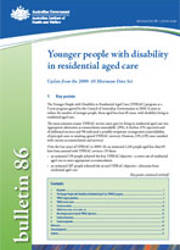Summary
The Younger People with Disability in Residential Aged Care (YPIRAC) program is a 5-year program agreed by the Council of Australian Governments in 2006. It aims to reduce the number of younger people, those aged less than 65 years, with disability living in residential aged care.
The most common reason YPIRAC service users gave for living in residential aged care was ‘appropriate alternative accommodation unavailable’ (39%). A further 27% reported need of additional services and 9% indicated a possibly temporary arrangement (unavailability of principal carer or awaiting agreed YPIRAC services). However, 23% (135) were ’satisfied with current accommodation and services’.
Over the four years of YPIRAC to 2009–10, an estimated 1,141 people aged less than 65 have been assisted with YPIRAC services. Of these:
- an estimated 139 people achieved the first YPIRAC objective—a move out of residential aged care to more appropriate accommodation
- an estimated 207 people achieved the second YPIRAC objective—diversion from residential aged care
- an estimated 409 people achieved the third YPIRAC objective—receiving enhanced services within residential aged care, when this was the only available, suitable accommodation option.
Over the same time frame, the number of people admitted to residential aged care who were aged less than 50 (the initial priority group of YPIRAC) has fallen by 22%, and the number living in residential aged care has fallen by 29%.
In 2009–10, the fourth year of YPIRAC, 943 people received YPIRAC services. Of these:
- 14% (131 service users) had moved from residential aged care to alternative accommodation
- 27% (253 service users) had agreed to move from residential aged care but had not yet done so
- 29% (275 service users) had elected to remain in residential aged care with additional services
- 25% (235) were receiving services to divert them from entering residential aged care.
A total of 172 service users received alternative accommodation in 2009–10, including 98 who had previously lived in residential aged care and 74 who were diverted from entering residential aged care. Another 521 service users received support services, such as therapy support or assistive products and technology.
Other characteristics of service users in 2009–10 include:
- nearly 50% (445 service users) reported a primary disability of ‘acquired brain injury’ and a further 30% (284) reported a ‘neurological’ primary disability
- 10%(96) were Aboriginal and Torres Strait Islander people
- 68%(639) were aged less than 50.



